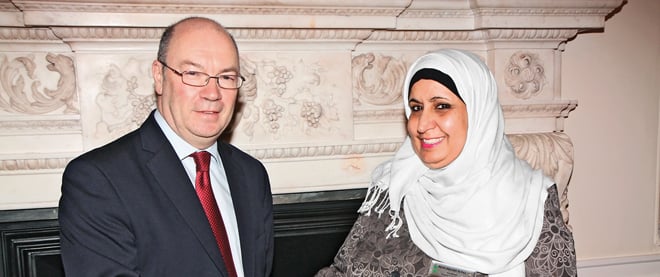Saudi cabinet minister caught without her niqab
But the country’s highest-ranking female official insists she always wears it
Courtesy of British Foreign and Commonwealth Office
Share

Saudi Arabia is not keen on women’s rights. Under their version of sharia law, women are not allowed to drive a car or even leave their homes without donning black robes. They must go everywhere with a male guardian and currently are not allowed to vote. At a United Nations summit in New York, Saudi Arabia’s ruling monarch, King Abdullah, once defended his country’s record on women’s rights: “It is absurd,” he said, “to impose on an individual or a society rights that are alien to its beliefs and principles.”
In 2009, Abdullah changed his tune, appointing Norah al-Faiz, a female teacher and mother of five to the post of deputy education minister. She remains the highest-ranking female official in the Saudi government, the first woman made a deputy minister. Progressives in the country were thrilled; Faiz became a symbol of change, although she is forced to interact with her male colleagues via a closed-circuit TV. It allows her to speak with them from another room, but bars them from seeing her. Still, “there was lots of excitement,” says Tara Huda Silver, a researcher with the Canadian Council of Muslim Women, particularly from Saudi women. Finally, it seemed the country was relaxing its grip on women’s freedoms.
Then came the photographs. Ever since her appointment, Faiz has been dogged by one of the world’s strangest political controversies. After her appointment, the Saudi newspaper al-Watan published a photo of the new minister wearing a white headscarf, her face exposed. Faiz claims she always wears a niqab, a face veil worn by conservative women. “I am a Saudi woman from Najd, and thus I wear the niqab,” she said, alluding to her extremely devout home region, where the niqab is virtually compulsory. “I will never allow the publishing of my photo in newspapers and I will not accept that it be put up anywhere.”
“The publication of the photo upset me immensely,” she told the newspaper. The strange thing is that since then, Faiz has been repeatedly photographed, and she’s never wearing a niqab. Earlier this month, a well-known Saudi doctor tweeted a photo of Faiz, in a head scarf, addressing Saudi graduates. Yet she continues to insist she wears it all the time. This has many Saudi progressives wondering how much real change there has been for women. Saudi blogger Ahmed Al Omran believes her repeated claims raise “troublesome questions about the prospects of those trying to reform the kingdom’s policies on women’s rights from inside the system.” In other words, if Faiz keeps rushing to appease religious fundamentalists, how optimistic can Saudis really be about her appointment?
Huda Silver says Faiz probably has no choice but to tread carefully where the niqab is concerned: she is trying to “strike a balance between the very conservative orthodox interpretation of Islam,” she says, “and the desire for change among marginalized women in Saudi Arabia.” Being a female leader in a deeply religious Muslim country is “a form of negotiation between the woman and the patriarchal culture in which she lives,” says Huda Silver. “You can’t just be a renegade.”